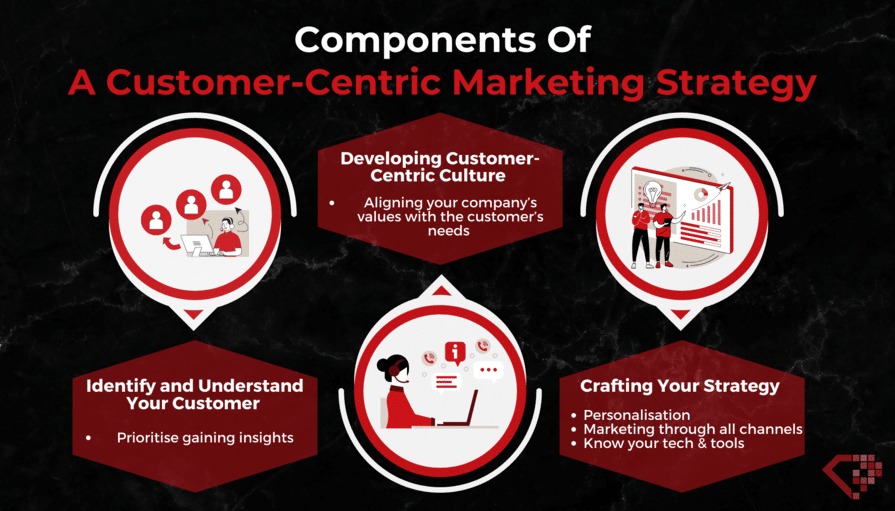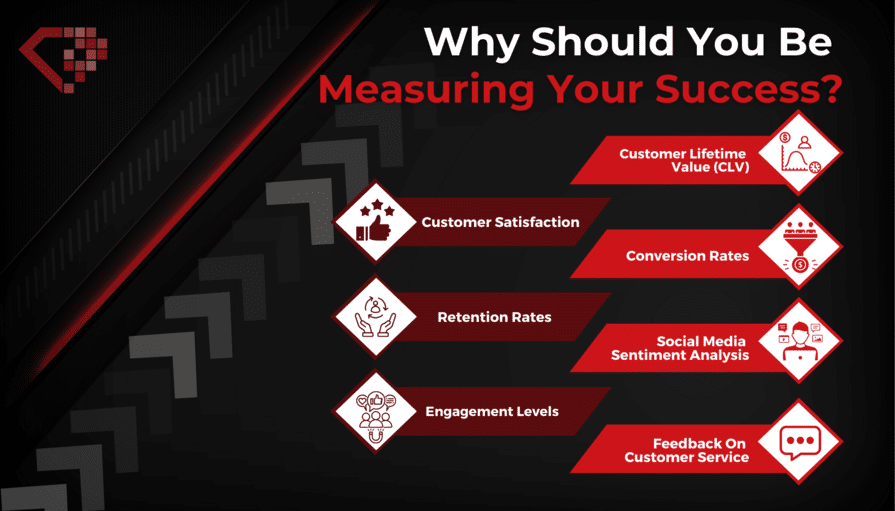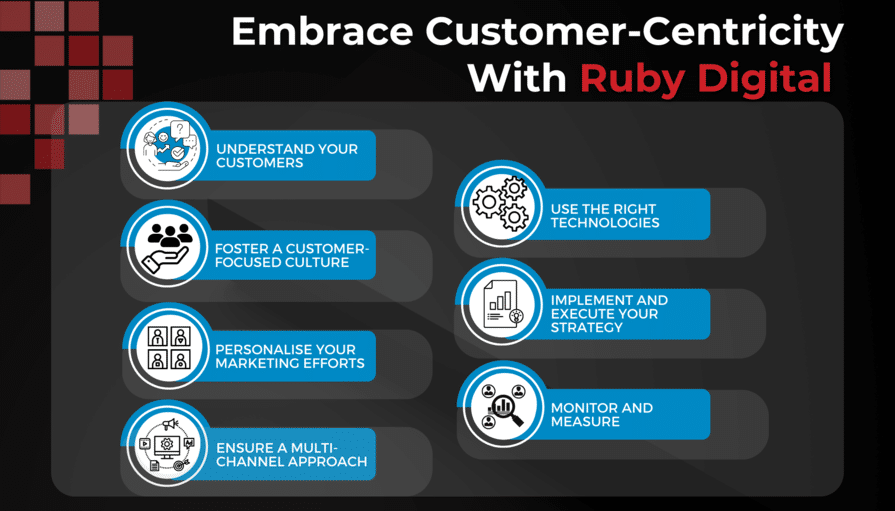A customer-centric strategy is all about focusing on your customers’ needs in every part of your marketing. It’s a shift from traditional marketing that often centres on the product, to a strategy where the customer is the main focus.
Why is this approach so important? The evidence speaks for itself. According to the Walker Index, from 1994 to 2018, companies that prioritised the customer perspective not only grew in value alongside major indices like NASDAQ, S&P, and Dow Jones but also showed remarkable resilience in downturns. They maintained their value longer, suffered less during market falls, and recovered faster from crashes like the dot-com bubble in 2000 and the 2008 stock market crash.
More recent studies, like one from Qualtrics’ XM Institute, mirror these findings. Companies with the best customer experience ratings notably outperformed those with poorer ratings, especially during the COVID recession in early 2020. This data strongly suggests that a customer-centric approach isn’t just good for customer relationships – it’s a solid business strategy that can lead to growth and resilience, even in tough times.
In this blog, we’ll explore the key elements of a successful customer-centric marketing strategy. We’ll see how focusing on your customers can transform your business and create a brand that truly resonates with your audience.
Components of a Customer-Centric Marketing Strategy
1. Identify and Understand Your Customer
The first step in building a customer-centric marketing strategy is to really know who your customers are. This means diving deep into customer-centric research. You need to gather as much information as possible about your customers’ preferences, behaviours, needs, and challenges.
This can be done through surveys, customer feedback, social media listening, and analysing customer data. Understanding your customers allows you to tailor your marketing efforts to meet their specific needs, making your approach more effective and personalised.
2. Developing a Customer-Centric Culture
Creating a customer centric culture within your organisation means aligning your company’s values and operations with your customers’ needs. It starts from the top, with leadership setting the tone, and filters down to every level of the company.
- Internal Training and Awareness: Educate your team about the importance of customer focus. Regular training sessions can help employees understand their role in delivering a customer-centric experience.
- Aligning Company Values: Ensure your company values reflect a commitment to customer satisfaction. This could mean prioritising customer service or adapting products and services based on customer feedback.
- Building a Customer-Centric Culture: This culture is about more than just customer service; it’s about considering the customer in every business decision and interaction. This approach ensures that every part of your organisation is working towards the same goal: customer satisfaction.
3. Crafting Your Strategy
- Personalisation Techniques
Personalising your marketing is key to a customer-centric approach. This means using customer data to deliver tailored messages and offers. Personalisation can range from simple tactics like using a customer’s name in emails, to more complex strategies like recommending products based on past purchases. - Marketing Through All Channels
To be truly customer-centric, you need to meet your customers where they are. This means having a presence on multiple channels, whether it’s social media, email, your website, or in-person. The goal is to provide a seamless, consistent experience across all these channels. - Know Your Technology and Tools
Understanding and effectively using the right technologies and tools is important too. This could include CRM systems, analytics tools, and marketing automation platforms. These tools can help you better understand and engage with your customers.

4. Implementation and Execution
Implementing and executing your strategy is the crucial next step. This is where partnering with an experienced customer centric digital marketing company like Ruby Digital can make a big difference. As experts in all aspects of marketing, we can help ensure that your customer-centric strategies are effectively put into action.
Ruby Digital’s team is skilled at coordinating our efforts to create a unified and cohesive customer journey. From the initial touchpoint to post-purchase follow-up, every step is designed to enhance the customer experience.
The digital landscape is always changing, and so are customer expectations. Ruby Digital’s approach isn’t just about implementing a strategy and leaving it at that. It’s about continuous monitoring, adapting, and improving. This agility ensures that the marketing efforts remain effective and relevant over time.
5. Measuring Your Success
Finally, it’s important to measure the success of your efforts. This involves tracking key metrics like customer satisfaction, retention rates, and engagement levels. Understanding what works and what doesn’t allow you to continuously refine and improve your strategy. Here are some key metrics to track and suggestions for monitoring them:
- Customer Satisfaction: This can be measured through surveys, customer feedback forms, and Net Promoter Score (NPS). Regularly ask your customers for feedback and rate their satisfaction levels.
- Retention Rates: Customer retention rates indicate how well you’re keeping your customers over time. This metric is crucial because retaining an existing customer is generally far more cost-effective than acquiring a new one. CRM software can help track customer interactions and purchases to see if customers are returning.
- Engagement Levels: Measure how customers are interacting with your brand across various channels. This includes social media interactions, email open and click-through rates, website traffic, and time spent on your site. Tools like Google Analytics, Hootsuite, or Mailchimp provide detailed insights into these engagement metrics.
- Customer Lifetime Value (CLV): CLV helps you understand the total worth of a customer to your business over the entire period of your relationship. This metric is important for making informed decisions about how much to invest in retaining customers and acquiring new ones.
- Conversion Rates: Track how many of the customers or leads interacting with your marketing efforts are taking the desired actions, such as making a purchase, signing up for a newsletter, or downloading a whitepaper.
- Social Media Sentiment Analysis: Use tools like Brandwatch or Hootsuite Insights to gauge public sentiment about your brand on social media. This helps understand customer perceptions and identify areas for improvement.
- Feedback on Customer Service: Monitor feedback regarding your customer service through direct customer feedback, social media monitoring, and customer service metrics like response time and resolution rate.

Regularly reviewing and analysing this data will give you valuable insights into how well your customer-centric strategy is working, and where you can make improvements. Remember, the goal isn’t just to gather data, but to use it to make informed decisions that enhance the customer experience and drive business growth.
Embrace Customer-Centricity with Ruby Digital
In closing, building a winning customer-centric marketing strategy is about prioritising the needs of your customers at every stage of your marketing efforts. From in-depth customer-centric research to developing a culture that revolves around customer satisfaction, every aspect of your strategy should be aligned with the goal of creating value for your customers.
Key Takeaways:
- Understand Your Customers: Dive deep into customer research to understand their needs and preferences.
- Foster a Customer-Focused Culture: Cultivate a culture within your business that prioritises customer satisfaction.
- Personalise Your Marketing Efforts: Use customer data to tailor your marketing messages and offer a more personalised experience.
- Ensure a Multi-Channel Approach: Reach your customers where they are by having a presence across various marketing channels.
- Use the Right Technologies: Leverage appropriate tools to enhance your understanding and engagement with customers.
- Implement and Execute Your Strategy: Put your plan into action with precision, adapting as needed for maximum impact.
- Monitor and Measure: Track key metrics to gauge the effectiveness of your strategy and make informed improvements.

At Ruby Digital, our expertise in digital marketing, analysis, and personalised content creation positions us perfectly to help you implement a customer-centric strategy. We understand the nuances of customer behaviours and preferences, and turn these insights into effective marketing strategies.
If you’re ready to place your customers at the heart of your business strategy, we’re here to help! Contact Ruby Digital today to start crafting a customer centric digital marketing strategy that not only meets but exceeds your customers’ expectations.



